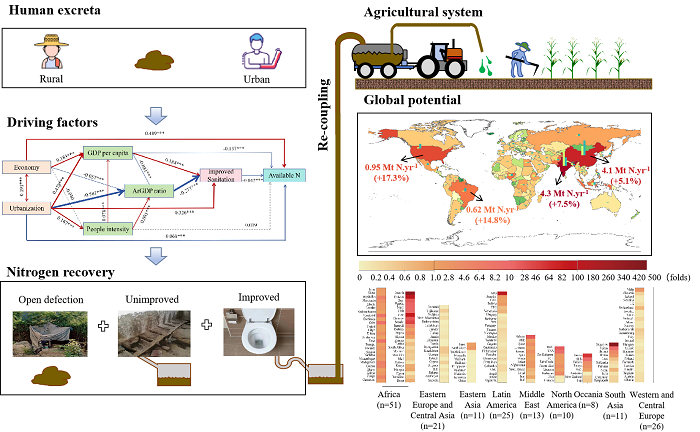Recently, the Agricultural Clean Watershed Innovation Team from the Institute of Environment and Sustainable Development in Agriculture, Chinese Academy of Agricultural Sciences, revealed how urbanization and economic development have driven improvements in sanitation facilities, thereby influencing the accessibility of nitrogen resources from human excreta fertilizer. The study explored the future potential and cost-effectiveness of substituting human excreta nitrogen for synthetic nitrogen fertilizers under sustainable development goals. The related findings were published in Process Safety and Environmental Protection.

Human excreta fertilizer is a potential nitrogen resource in agricultural systems. The Chinese term "米田共" (a euphemism for feces) reflects that early humans understood the green recycling of agricultural nutrients from human excreta. However, global urbanization and the widespread use of flush toilets have disrupted the green cycle of returning human excreta to farmland as fertilizer, thus neglecting its potential to recycle nitrogen back into agriculture. In response, this study constructed a panel dataset covering factors like population, economy, and sanitation facilities, and quantified the theoretical potential of nitrogen from human excreta globally.
The study found significant regional distribution characteristics for human excreta nitrogen resources. Population size, economic conditions, urbanization rate, and sanitation facilities were identified as key factors affecting the accessibility of nitrogen from human excreta. In the context of future population growth, re-integrating human excreta nitrogen as part of agricultural systems could meet the enormous demand for agricultural nitrogen. This research provides a theoretical foundation for global collaboration on utilizing human excreta nitrogen resources and the collection, transport, and processing technologies for excreta fertilizers.
The study was supported by the National Key R&D Program and the Agricultural Science and Technology Innovation Program of the Chinese Academy of Agricultural Sciences.
Linkage: https://www.sciencedirect.com/science/article/pii/S0957582024012242

